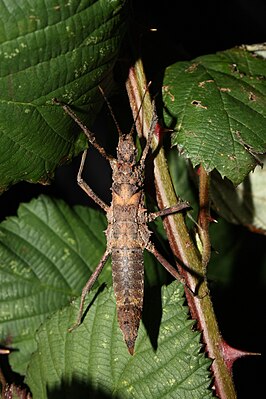Hoploclonia cuspidata
| Hoploclonia cuspidata | ||||||||||||
|---|---|---|---|---|---|---|---|---|---|---|---|---|

Hoploclonia cuspidata , female |
||||||||||||
| Systematics | ||||||||||||
|
||||||||||||
| Scientific name | ||||||||||||
| Hoploclonia cuspidata | ||||||||||||
| Redtenbacher , 1906 |

Hoploclonia cuspidata is aspecies of ghost thatis native tothe north of the island of Borneo .
features
The animals, which are wingless in both sexes, have the thorns typical of representatives of this genus on their bodies. These are found in pairs in the 30 to 35 millimeter long males on the head, thorax and anterior segments of the abdomen . In adult males a dark, mostly black-brown basic color dominates. Only the areas around the hips , as well as the distal ends of the legs and the proximal ends of the splints , i.e. the knee area, are colored yellow to orange and form a clear contrast to the basic color.
The females are 45 to 52 millimeters long. They are usually lighter in color and significantly more variable in color. Their basic color can vary from light brown to reddish brown to dark brown. Only on the thorax they carry significant, very flat arranged spines on the Mesothorax this for Hoploclonia form typical TYPES triangle. Overall, they are very robust in terms of habit . The abdomen in egg-laying females is plump and approximately cylindrical in cross-section. The end of the abdomen forms a short laying spine for laying the eggs in the ground.
distribution
Hoploclonia cuspidata is native to the north of the island of Borneo. Its main area of distribution is the Sultanate of Brunei , which is why the species is also called "Brunei Hoploclonia Stick Insect" in the English-speaking world. Further evidence is available for the Malay areas near Brunei. Animals have been found in the west of Sabah and in the northwest of Sarawak .
Way of life and reproduction
In addition to sexual reproduction , facultative parthenogenesis has also been proven in this species . Like most well-camouflaged ghosts, Hoploclonia cuspidata also hides during the day and only comes out of hiding places near the ground at dusk to feed and look for a partner. With their laying stinger, the females pierce the eggs 3.5 to 3.7 mm long, 2.8 to 2.9 mm high and 2.5 mm wide into the ground. As is typical for all Hoploclonia species, these are more arched on the dorsal side and thus have a lid that slopes down towards the ventral side. Your micropylar plate has three legs, one leg pointing towards the lid, while the other two are narrower and run laterally in the direction of the lower pole (see also the construction of the phasmid egg ). The nymphs need to slip, depending on the air three to five months and then have a length of 12 mm. They are initially black and have red-brown legs. Female nymphs are about 27 mm long in the third stage. Their legs are much more reddish in color and they lack any spines. It takes at least six months until the imaginal molt, often more in the case of females.
Systematics
When Josef Redtenbacher described the species in 1906, both males and females were available to him. However, he only recognized that the female belongs to the genus Hoploclonia , which was established by Carl Stål in 1875 . This was monotypical until then . Although both males and females were known from the hitherto only representative of the genus, namely Hoploclonia gecko , Redtenbacher described the male of Hoploclonia cuspidata as Dares (Epidares) haematacanthus . The type material was long thought to be lost. This was rediscovered in 2000 by Oliver Zompro . A lectotype is stored in the Museum für Tierkunde Dresden and another syntype in the Museum für Naturkunde (Berlin) . In 1998 Philip Bragg initially transferred the species from the genus Dares to the taxon Epidares, which is now listed as a genus . However, once the type material was available , he synonymous the species with Hoploclonia cuspidata as early as 2001 . A 52 mm long female is deposited as the Holopypus of Hoploclonia cuspidata in the Muséum national d'histoire naturelle in Paris .
Terrariums
In the terrarium hobby , the first breeding lines appeared in the mid-1990s. These go back to animals that Ian Abercrombie had collected and bred in 1994 in Brunei, more precisely in Kuala Belalong . The species received PSG number 199 from the Phasmid Study Group.
The keeping of Hoploclonia cuspidata is considered to be delicate. Only small terrariums are required. These should contain a substrate that is always slightly moist and suitable for laying eggs on the terrarium floor. The humidity in the terrarium should also be rather high at 70 to 90 percent. Blackberry , raspberry and oak leaves are eaten .
photos
Web links
Individual evidence
- ↑ a b c Phasmid page from Frank H. Hennemann & Oskar V. Conle ( Memento of the original from May 2, 2011 in the Internet Archive ) Info: The archive link was automatically inserted and not yet checked. Please check the original and archive link according to the instructions and then remove this notice.
- ↑ a b c d Philip E. Bragg : Phasmids of Borneo , Natural History Publikations (Borneo) Sdn. Bhd., Kota Kinabalu, Sabah, Malaysia, 2001, pp. 117-119, ISBN 983-812-027-8
- ↑ a b c stabschrecken.com: Posture reports -Streeching, ghosts, walking leaves , iter novellum Verlag, Saarbrücken 2010, p. 79, ISBN 978-3-00-031913-6
- ^ Paul D. Brock : Phasmida Species File Online . Version 2.1 / 4.0. (accessed on January 2, 2011)
- ↑ Phasmid Study Group Culture List ( Memento from December 5, 2012 in the web archive archive.today ) (English)



